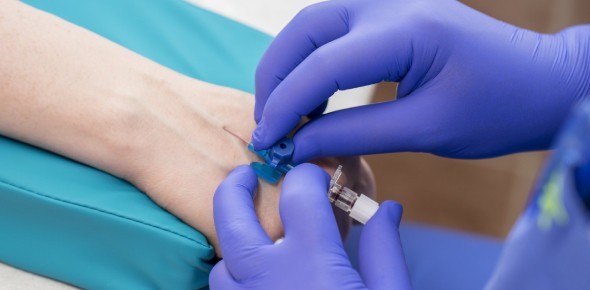A nurse is caring for a client who is postoperative following a total left hip arthroplasty. Which of the following actions should the nurse take?
Cross the client's legs when sitting in the recliner.
Provide a heating pad to the operative hip.
Place a pillow between the legs when turning the client to their side.
Have the client lean forward when assisting them out of the bed.
The Correct Answer is C
Choice A rationale:
The nurse should not cross the client's legs when sitting in the recliner following a total left hip arthroplasty. Crossing the legs can put strain on the operative hip and may increase the risk of dislocation or other complications.
Choice B rationale:
Providing a heating pad to the operative hip is not recommended. Heat can increase blood flow to the area and may lead to increased swelling and potential complications in the postoperative period.
Choice C rationale:

Placing a pillow between the legs when turning the client to their side is the correct action. This technique is known as the "abduction pillow”. or "wedge pillow.”. It helps maintain proper hip alignment and prevents the operated leg from crossing the midline, reducing the risk of dislocation and promoting healing.
Choice D rationale:
Having the client lean forward when assisting them out of the bed is not appropriate after a total left hip arthroplasty. Leaning forward can put strain on the hip joint and increase the risk of injury.
Nursing Test Bank
Naxlex Comprehensive Predictor Exams
Related Questions
Correct Answer is C
Explanation
Verify that the client has adequate IV access.

Choice A rationale:
Administering vasopressin to the client might be necessary to manage the hemorrhage, but before any medication administration, it is crucial to ensure the client has adequate IV access. Vasopressin is a vasoconstrictor and can help control bleeding from esophageal varices, but its effectiveness relies on IV access to deliver the medication promptly.
Choice B rationale:
Requesting blood from the blood bank is essential for a client experiencing significant bleeding. However, the priority action is to verify IV access to administer any necessary blood products.
Choice C rationale:
This is the correct choice. Before initiating any interventions, ensuring the client has appropriate IV access is a priority. Adequate IV access is necessary to administer fluids, medications, or blood products promptly and effectively stabilize the client's blood pressure.
Choice D rationale:
Inserting an indwelling urinary catheter is not the priority action in this situation. While monitoring urine output is important, it should be secondary to addressing the client's hypotension and hemorrhage.
Correct Answer is C
Explanation
Choice A rationale:
Difficulty maintaining personal hygiene is not typically an early indication of mild Alzheimer's disease. In the early stages, individuals can still manage personal hygiene.
Choice B rationale:
Difficulty handling finances may occur in the later stages of Alzheimer's disease, but it is not an early indication. In the early stages, the person might still manage financial matters.
Choice C rationale:
Difficulty remembering the names of new friends is a common early sign of mild Alzheimer's disease. It reflects the impairment of short-term memory that often occurs in the early stages of the disease.
Choice D rationale:
Difficulty driving to and from familiar places is more likely to be a mid-to-late-stage symptom of Alzheimer's disease. In the early stages, individuals might still drive familiar routes with minimal difficulty.
Whether you are a student looking to ace your exams or a practicing nurse seeking to enhance your expertise , our nursing education contents will empower you with the confidence and competence to make a difference in the lives of patients and become a respected leader in the healthcare field.
Visit Naxlex, invest in your future and unlock endless possibilities with our unparalleled nursing education contents today
Report Wrong Answer on the Current Question
Do you disagree with the answer? If yes, what is your expected answer? Explain.
Kindly be descriptive with the issue you are facing.
